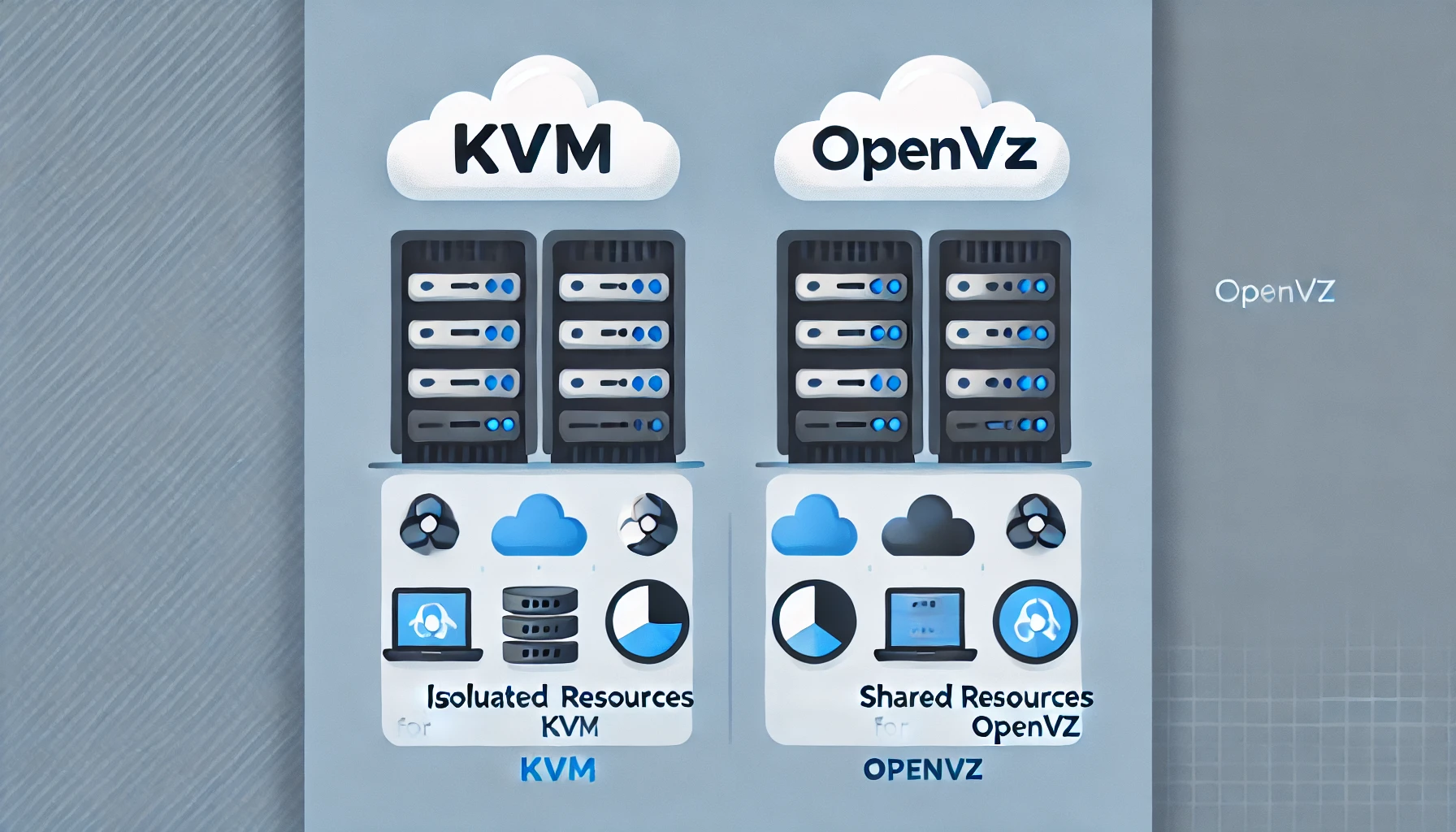When it comes to VPS (Virtual Private Server) hosting, two popular virtualization technologies stand out: KVM (Kernel-based Virtual Machine) and OpenVZ. Both are used to create virtualized environments, but they differ significantly in how they allocate resources, manage security, and support customization. In this guide, we’ll explore the key differences between KVM and OpenVZ, helping you choose the right solution for your specific hosting needs.
What is KVM?
KVM (Kernel-based Virtual Machine) is a full virtualization technology integrated into the Linux kernel. It allows each virtual machine (VM) to operate with its own isolated kernel, providing a fully independent environment. KVM virtualization behaves like a dedicated server, giving each user complete control over resources and configurations.
Key Features of KVM:
- Full Virtualization: KVM provides an independent operating system for each virtual machine, allowing for a true “bare-metal” experience.
- Wide OS Support: KVM can host multiple operating systems, including Linux, Windows, and BSD.
- Dedicated Resources: Each VM gets dedicated CPU, RAM, and storage, improving performance consistency.
- Customization: With root access, users have the flexibility to customize the server environment, install applications, and configure security settings.
What is OpenVZ?
OpenVZ is a container-based virtualization technology specifically designed for Linux systems. Unlike KVM, OpenVZ shares the host’s kernel across all virtual instances, making it more lightweight and efficient but with certain limitations on customization and operating system compatibility.
Key Features of OpenVZ:
- Container-Based Virtualization: OpenVZ uses containers that share the host’s kernel, making it lighter on system resources.
- Linux-Only: OpenVZ only supports Linux operating systems, as all virtual containers depend on the host’s kernel.
- Resource Efficiency: With shared resources and kernel, OpenVZ can host more containers on the same server compared to KVM, making it cost-effective.
- Basic Customization: While OpenVZ allows for some customization, it is limited compared to KVM’s flexibility.
KVM vs. OpenVZ: Key Differences
| Feature | KVM (Kernel-based Virtual Machine) | OpenVZ |
|---|---|---|
| Virtualization Type | Full virtualization (hardware-based) | Container-based (OS-level) |
| Kernel | Independent kernel per VM | Shared host kernel |
| Operating System Support | Supports Linux, Windows, BSD | Linux only |
| Performance | High, with dedicated resources | High, with shared resources |
| Resource Allocation | Dedicated resources (CPU, RAM, etc.) | Shared resources |
| Security and Isolation | High isolation between VMs | Limited isolation |
| Customization | Full root access, flexible configurations | Limited customization |
| Use Case | High-performance needs, complex apps | Lightweight, cost-effective containers |
Advantages of KVM
-
Enhanced Security and Isolation
Each KVM VM operates with an independent kernel, providing higher security and better isolation from other VMs. This setup minimizes risks of interference from neighboring virtual machines, making KVM a reliable choice for hosting sensitive applications. -
Support for Multiple Operating Systems
KVM allows you to run multiple operating systems, including Linux, Windows, and BSD, which makes it versatile for diverse software needs. -
Dedicated Resources
Resources like CPU, RAM, and storage are allocated specifically to each KVM VM, providing consistent performance. This setup is ideal for high-traffic websites or applications that require stable resources. -
Full Customization
KVM grants root access and full control, allowing you to configure the server as needed. Whether installing specific applications or implementing security measures, KVM offers flexibility for advanced users.
Advantages of OpenVZ
-
Resource Efficiency
Since OpenVZ uses a single shared kernel, it is more efficient with resources. This setup allows providers to host more containers on the same hardware, making it a budget-friendly option for users. -
Faster Setup and Maintenance
OpenVZ containers are quick to deploy, and management is simplified due to the shared kernel. This makes OpenVZ ideal for developers who need quick access to test environments. -
Lightweight Performance
OpenVZ containers have lower overhead compared to KVM, which means applications can operate smoothly, making it suitable for small to medium-sized websites or applications with moderate traffic. -
Cost-Effective
With efficient resource allocation, OpenVZ is often more affordable, providing a budget-friendly option for users who don’t require high customization or diverse operating system support.
Choosing Between KVM and OpenVZ
When deciding between KVM and OpenVZ, consider your specific hosting needs:
-
Choose KVM If You Need:
- High performance and stability for resource-intensive applications
- Support for multiple operating systems (Linux, Windows, BSD)
- High security and isolation for sensitive applications
- Full customization and root access
-
Choose OpenVZ If You Need:
- A lightweight, cost-effective solution for Linux applications
- Quick deployment for development and testing environments
- Low to moderate resource demands
- Budget-friendly hosting without complex requirements
Both KVM and OpenVZ offer powerful solutions for VPS hosting, but each is suited to different needs. KVM is the preferred choice for high-performance applications that require dedicated resources, advanced customization, and security. OpenVZ, on the other hand, is ideal for lightweight applications and developers needing a cost-effective, Linux-only environment.
Understanding these differences will help you select the virtualization that aligns best with your hosting goals, whether you’re building a high-traffic website, testing software, or hosting business applications.

